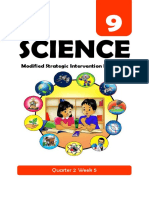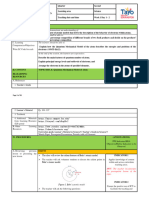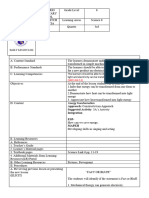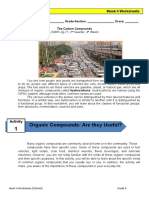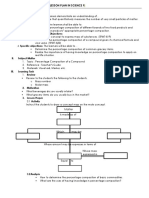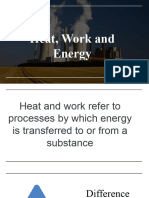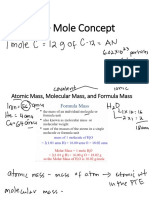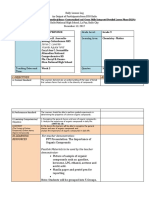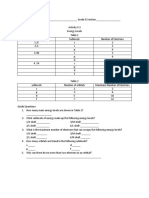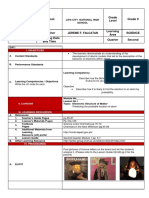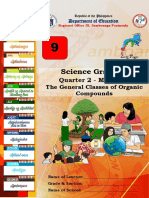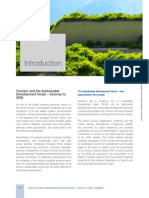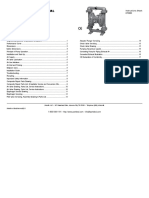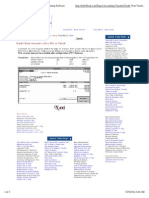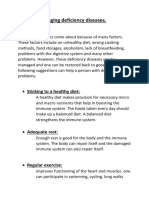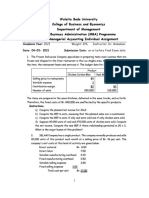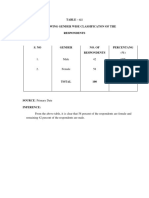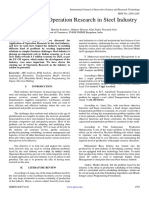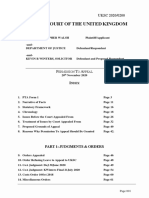Module 5
Super C: You See Everywhere
SCIENCE 9
2nd QUARTER
Module 5
Most Essential Learning Competency
⚫ Explain how the structure of the carbon atom affects the type of bonds it forms; (S9MT-
IIg-h-17)
To the Learner
This module was specially designed to help you understand and apply the lesson
objectives. Read and follow the simple instructions as your guide.
1. Set a conducive learning space at home so you can focus on your studies.
2. Seek assistance from your parents or guardian to guide you in doing the
activities.
3. Take down important concepts and list questions you would like to ask from
your teacher.
4. Reflect and apply the concepts that you have learned.
The Writer
� Module 5
Super C: You See Everywhere
Expectations
In this module, you will explain how the structure of the carbon
atom affects the type of bonds it forms.
Specifically, this material will help you to:
1. determine the different uses of organic compounds and cite examples of each
organic compound; and
2. find the properties of common organic compounds through experimentation.
Pretest
Let us start your journey in learning the properties of organic
compounds and their example. I am sure you are ready and excited
to answer the Pre-test. Smile and cheer up!
Directions: Read each statement carefully. Choose the letter of the correct answer.
Write the letter of the correct answer on your answer sheet.
_____1. Which of the following building materials is organic?
A. Cement B. Floor tiles C. Iron grills D. Wood
_____2. Which of the following best explains why it is prohibited to smoke near
the gasoline stations.
A. The smoke can cause illness to the employee.
B. Gasoline evaporates easily in hot temperature.
C. It can ignite gasoline vapor and cause the gas can to explode.
D. All of the above
______3. Ana accidentally fell while playing and had a scratch in her knees. What
will she apply to make her wounds free from bacteria?
A. Acetone B. Formalin C. Isopropyl alcohol D. Water
______4. Which are TRUE about organic compounds?
I. organic compounds can be produced artificially
II. organic compounds can be produced by living organisms
III. organic compounds contain calcium
IV. organic compounds contain carbon
A. I, II and III only C. II and III only
B. I and III only D. II, III and IV only
______5. Why do we need to know the different properties of common organic
materials found at home?
A. To identify their uses
B. To know possible danger from these kinds of material
C. To know how these organic materials affect people and other organisms
D. All of the above
Great! You finished answering the questions. You may request
your guardian to check your work. Congratulations and keep on
learning!
2
� Module 5
Super C: You See Everywhere
Looking Back
Have you ever heard the word organic? Yes! You’re right.
You are familiar because you use this word in food or farming
industry methods. Something related to living things organic
matter. Others define it as carbon-containing compounds. Why
Carbon? Carbon is the element with atomic number 6 and an
electron configuration of 1S2 2S2 2p2. Carbon atoms show a very
strong tendency to share electrons and form covalent bonds. It
can also form covalent bonds with several elements and can form
multiple bonds with itself in unlimited chains or with selected
elements such as oxygen, hydrogen, sulfur and nitrogen.
Directions: Identify the compound if it is Organic or Inorganic. Write the answer
on the answer sheet.
Compound Chemical Structure Choices
1. Carbon Monoxide
Organic Inorganic
2. Vitamin C
Organic Inorganic
3. Ammonia
Organic Inorganic
4. Sodium
Bicarbonate
Organic Inorganic
Jayson P. Darapiza/Victoria Tañedo
3
� Module 5
Super C: You See Everywhere
5. Ethyl Alcohol
Organic Inorganic
Illustrator: Jayson P. Darapiza
Cyanides, bicarbonates, carbonates, and some other carbon-containing compounds
were classified as "inorganic" because of their source: they can be obtained in large
quantity from minerals.
Brief Introduction
Today there are about 13 million synthetic and natural carbon
compounds known. Why are there many compounds of
carbon? What are the different uses of these organic
compounds? What is it about carbon that makes it unique?
We will find it out as we go through series of activities. What
are you waiting for? Let’s go!
The organic compounds contain carbon chemically bound to hydrogen. They
often contain other elements namely oxygen, nitrogen, phosphorous, sulfur, and
some halogens like fluorine, chlorine, bromine, and iodine. Many of these organic
compounds are found inside your home and it is essential in our daily lives. Ethyl
alcohol, acetone, naphthalene, acetic acid, vitamins, and table sugar are just a few
examples of many useful organic compounds. These kinds of compounds are
produced by plants and animals. However, these carbon-containing compounds can
also be produced artificially. There are also organic compounds that are produced
from petroleum: liquefied petroleum gas (LPG), gasoline, lubricating oil, and
kerosene. These compounds have different uses in the community.
In every kind of organic compound, there are specific properties or
characteristics. Yes, it might be quite similar to one another, but it is not the same.
For instance, gasoline, kerosene, diesel oil, lubricating oil, acetic acid, and ethyl
alcohol are all organic compounds with different properties. Gasoline, for example,
has a strong odor, is volatile, and highly flammable.
4
� Module 5
Super C: You See Everywhere
Activity 1: Mighty Super C
Objective: In this activity, you will be able to classify common organic compounds
based on their uses.
Directions: Below is the list of common Organic compounds. Classify them
according to their uses by putting a check mark on the corresponding column. Note
that you may have more than one check mark per sample depending on its use/s.
Write your answer on the answer sheet.
Organic Uses of Organic Compounds
Compounds Antiseptic Beverage Cleaner Disinfectants Food Fuel
1. Acetone
2. Vitamin C
3.Petroleum
gas
4. Wine
5. Air
fresheners
6. Formalin
7. Kerosene
8. Vinegar or
acetic acid
9. Butane
10.Vegetable
Oil
Guide Question: Write your answer on your answer sheet.
1. Why do you think these organic compounds are very important in our home?
Check this out:
Organic Chemistry is the study of carbon-containing molecules known as
organic compounds. Your computer, furniture, home, vehicle, food,
and body contain organic compounds.
5
� Module 5
Super C: You See Everywhere
Activity 2: Super C and its Powers
Objectives: Describe and differentiate the property of the organic
Compounds through experimentation and state the importance of
these properties.
Materials:
Cooking oil Stopwatch 1 ballpen tube
Acetone (Nail Polish Remover) Paper and Pen 1 pcs of bond paper
Kerosene (Lamp oil) Calculator 4 old metal spoon
Rubbing Alcohol Matches Masking tape
1 Candle stick Wet Rag Water
Water Glass (Drinkware) 4 medicine droppers
Procedure:
1. Before you start, find the safest place in your house where you can do your
experiment.
a. Using a medicine dropper, put 5 drops of liquid materials in each old metal
spoon.
b. Label each old metal spoon as A. Cooking oil, B. for Acetone, C for
kerosene and D for Rubbing alcohol as shown in the figure below.
A B C D
c. Observe and identify whether the substance is solid liquid or gas and write
it in table below.
d. Smell each substance using the wafting technique. (Wave your hand from
the substance to your nose). Record your observation.
2. Test of flammability (a measure of how a material easily burns)
a. Light the candle using the match and place it in substance A.
Precautions: Be careful and make sure that each substance is far from one
another. Use the wet rag in case the fire spread in your working area. Ask
your guardian to assist you in doing this activity.
b. Record the time for the substance to burn completely.
c. Repeat steps a and b in substance B, C and D.
3. Test of Viscosity (is a measure of fluid’s resistance to flow)
a. In this activity, you need only the tube of the ballpen. Remove the Ink
chamber.
b. Open the Tip of the ballpen, then half-fill it using the Substance A.
c. Invert the Ballpen so that the substance will not flow. When the timer is
ready. Quickly turn the ballpen tube in an upright position. Make sure that
you have a cup to catch the substance.
d. Record the time it takes for the substance to flow completely.
e. Wash the ballpen tube with water and repeat steps a to d for substance B, C
and D.
6
� Module 5
Super C: You See Everywhere
4. Test of Solubility (is a measure for a substance to dissolve in water)
a. Using the old metal spoon, prepare 5 spoons of Substance A.
b. Then, mix them in a half glass of water using an old metal spoon. Set it off a
minute until the bubbles disappear.
c. Record your observation and repeat steps a to c for Substance B, C and D.
5. Test of Volatility (is a measure of the tendency of a substance to evaporate)
a. Fold the bond paper into 4. Label each side as Substance A, B, C and D.
b. Using a medicine dropper, put two drops of each liquid material at the same
time.
c. Record the time it takes the paper to get dry. This is equivalent to the time it
takes the liquid to completely evaporate.
Based on your experiment, complete the table below. Write your answer on the
answer sheet.
Substance Phase Odor Flammability Viscosity Solubility Volatility
(Solid, (Strong, Time it takes Time it (Soluble- Time it
Liquid, Weak) for the takes for mix as one takes the
Gas) substance to the Insoluble- substance
burn substance separate to
completely to flow into two-) evaporate
completely
A. Cooking
Oil
B. Acetone
C.
Kerosene
D. Rubbing
Alcohol
Guide Questions: Write your answer on your answer sheet.
1. What is/are the similarities of all given substance?
___________________________________________________________________________
2. Which substance have the strongest odor?
___________________________________________________________________________
3. Which substances have the weakest odor?
___________________________________________________________________________
4. Which substances are flammable?
___________________________________________________________________________
5. In what ways are these flammable substances used?
___________________________________________________________________________
6. Which substance flowed slowly or most viscous?
___________________________________________________________________________
7. What are the common uses of viscous substance?
___________________________________________________________________________
8. Which substance/s mixed with water completely?
___________________________________________________________________________
9. Which substance evaporated the fastest?
___________________________________________________________________________
10.Why is it important to know the properties of these kinds of organic
compounds?______________________________________________________________
___________________________________________________________________________
7
� Module 5
Super C: You See Everywhere
Check this out:
Properties of organic Compounds may vary according to their functional Group.
Functional groups are specific groups of atoms within molecules, that are
responsible for the characteristic chemical reactions of those molecules. It is
important to be able to recognize the functional groups and the physical and
chemical properties that they afford compounds.
Remember
➢ Organic compounds are found everywhere around us in
our daily life and even inside our body.
➢ They always contain carbon and hydrogen atoms
and may also have other nonmetals such as oxygen,
sulfur, nitrogen or a halogen.
➢ they are found in common products such as food,
flavors, fragrances, medicine, toiletries, paints, and fuel
➢ The properties of some common organic compounds are related to their uses.
➢ In general, most of organic substances are inflammable and catch fire easily.
Some dissolves in water like alcohol. Ethyl is volatile and the cooking oil is a
viscous liquid.
➢ Organic compounds are also classified according to their functional groups.
Functional groups are group of atoms bonded in specific way. Compounds
that contain the same functional group have similar physical and chemical
properties.
Check Your Understanding
Congratulations! You made it this far…It’s time to check your
understanding by answering the questions using the illustration below.
Write your answer on your answer sheet.
1. Why do you think Super C scolded the
gasoline Boy? ____________________________
_________________________________________
_________________________________________
_________________________________________
Jayson P. Darapiza/ Victoria Tañedo
2. Why do people often uses oil to lubricate the
gears of a bicycle? _______________________
__________________________________________
__________________________________________
Jayson P. Darapiza/ Victoria Tañedo
8
� Module 5
Super C: You See Everywhere
3. Why do you think a man use kerosene and
not water in removing the paint in the
paintbrush? _____________________________
__________________________________________
__________________________________________
Jayson P. Darapiza/ Victoria Tañedo
Posttest
It’s now time to evaluate your learning. Answer
the post-test now. Goodluck!
Directions: Read each statement carefully. Choose the letter of the correct
answer. Write your answer on your answer sheet.
______1. Which element is always present in organic Compounds?
A. Calcium B. Carbon C. Chlorine D. Copper
______2. Which are TRUE about the use of isopropyl alcohol?
I. cleaner III. fuel
II. disinfectant IV. fertilizer
A. I and II only C. III and IV only
B. II and III only D. I and IV only
______3. Anna mixed oil and water. She observed that the oil
floats on water. What property of an organic
compound was exhibited by oil?
A. Oil is soluble in water.
B. Oil is insoluble in water.
C. Oil is not viscous so it floats on water.
D. Oil floats on water because it easily evaporates.
______4. Which of the following organic compounds has a weak volatility?
A. Acetone C. Kerosene
B. formaldehyde D. Perfumes
______5. Vicky’s car stopped at the middle of the road. She found out that her
car has ran out of fuel. Which compound must she buy?
A. kerosene C. lubricating oil
B. gasoline D. water
Excellent! You are almost done.
Congratulations!
9
� Module 5
Super C: You See Everywhere
Reflection
It’s time to reflect! Let us see what you learned by answering
the question based on what you know before and after using
this module.
REFLECTIVE LEARNING SHEET
Directions: Write a reflective learning on how you use of different organic
compounds at home and its relation to its properties. Complete all the statements
below. You can be more creative in presenting your learning.
Organic Chemistry is
______________________________________________________________________
______________________________________________________________________
Draw or paste cut-outs at least 3 other examples of Organic Compounds
found at home and give its uses.
Properties of Organic Compounds:
My conclusion on the lesson
__________________________________________________________________________
____________________________________________________________________
Congratulations! You are awesome.
Thanks for completing all the tasks.
10

